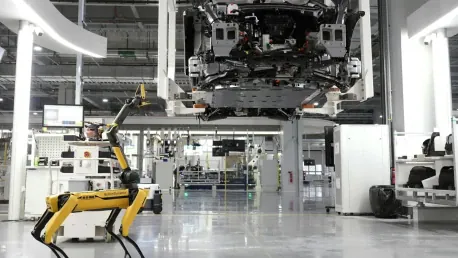Listen to the Article
Today, digital technologies are simplifying, streamlining, and boosting the efficiency of critical processes across industries. For manufacturers, the rise of intelligent tools presents opportunities to build an integrated ecosystem of instruments and systems that work together to create entirely autonomous operations, from decision-making and planning to development and production.
This will empower manufacturers to gain agility to enable quick responses to market changes, resilience against operational threats and risks, and sustainability to reduce waste and improve energy efficiency. But what does a smart factory look like? This article will unpack four key applications of advanced digital technologies from global manufacturers, revealing the foundation of a highly advanced and connected manufacturing facility.
Setting the Foundation for Industry 5.0
To define a smart factory, it’s important to understand where it fits in the Industry 4.0 landscape and the journey toward Industry 5.0, which is an emerging manufacturing concept characterized by the interconnectedness of people and technology in this sector. As with many of today’s newest technologies, the smart factory is not a replacement for human workers. Instead, it should be used to fast-track production, improve adherence to organizational and industry standards, and empower people to focus their attention on work that cannot be automated or streamlined through data-driven practices.
The smart factory is also a vital stepping stone on the path toward a sustainable future of product development, meaning that embracing connected capabilities has become an inevitability rather than an option.
Industrial Internet of Things
Caterpillar, the world’s leading manufacturer of mining and construction equipment, took to the Las Vegas MINExpo 2021 to launch Connected Worker, a smart safety and productivity solution that enables worker safety across mining sites.
As an addition to the Cat® MineStar™ Detect portfolio, the platform uses the combined power of smart wearable technology, advanced analytics, and Internet of Things (IoT) to protect workers. It provides real-time notifications and warnings of dangerous on-site areas and potential exposures to hazardous or risky environmental elements, following up these alerts with evacuation instructions, SOS signals, geofence violations, or fall detections.
The Caterpillar Connected Worker System comes in three wearable forms to improve flexibility. With the H1 Hardhat, a digitally-enabled version of the traditional piece of personal protective equipment, workers’ indoor locations can be determined using a global navigation satellite systems (GNSS) chip and 3D-tracking capabilities that provide longitudinal, latitudinal, and elevation information.
The second option, a T1 wearable tag, offers the same GNSS and tracking capabilities for outdoor sites. Similar to the hardhat, the tag allows for video and audio communication so that workers can report on-site hazards to safety teams to create geofences around the risk areas. Thirdly, Connected Worker can also be deployed as a smartphone app for Android devices, enabling field and safety teams to communicate seamlessly, share SOS alerts, and capture data to report on-site risks.
With the Connected Worker portfolio, companies ensure a safer and more efficient work environment for their workforce, enabling the communication capabilities and transparency a modern enterprise needs.
Data and Analytics
John Deere, the world’s largest farm machinery manufacturer, saved $900 million in inventory control over 2 years. To boost machine performance across its facilities, the company implemented an innovative machine monitoring system, allowing for the generation of real-time insights across 90,000 machines.
This approach empowered John Deere with advanced telematics capabilities to record key metrics, including location, utilization hours, idle time, temperatures, fault codes, and fuel consumption—ultimately helping to improve machine uptime at the organization.
With this innovative network, John Deere also leverages the benefits of advanced data analytics tools. Using these capabilities, maintenance teams can receive updates and alerts regarding potential machine failures and can determine whether the same issues are present in other machines across the fleet.
John Deere’s data and analytics transformation also incorporated an innovative location intelligence deployment, aiding in product research and market development. For example, this technology enables the company’s dealerships to establish the value of certain sites and areas where the organization may be looking to invest.
Using AI-powered analysis, dealers can compare key characteristics like land cover, customer sales, and demographics, as well as revenue projections, to highlight top opportunity areas at a granular level.
The comprehensive visibility that intelligent data and analytics deployments can enable gives companies a massive competitive advantage, especially in today’s world of remote and hybrid work. By using these tools to inform vital decisions and future investment plans, businesses can unlock truly future-proof manufacturing operations.
Robotics and Automation
Schneider Electric is a multinational provider of energy and automation digital solutions. To reduce its reliance on time-consuming tasks that offered no real value and improve IT agility, Schneider Electric decided to implement robotic process automation across its global supply chain.
For example, the process of loading parts onto a quality check station can be automated, giving employees time to focus on more important work. In an age defined by efficiency and growing demands on production, deploying RPA solutions is a significant step toward a competitive advantage.
However, the mechanical integration needs to be accompanied by comprehensive risk checks, security reinforcements, equipment modifications, and sufficient employee training. The chosen technology also needed customization that would allow it to manage slight product variations as they passed through the machine. Ultimately, this added complexity to the solution evaluation process.
After visiting several trade exhibitions, Schneider Electric’s expert team determined that Universal Robots’ cobots were the solution they needed for their RPA implementation initiative.
Simon Broze of ICA Industrial Automation, which works closely with the Belgian distributor of Universal Robotics, had this to say about the solution: “The main advantage of Universal Robots’ cobot is the flexibility, which allows it to be adapted to different products. Even with relatively complex movements, the mechanical integration poses few problems.”
In short, Schneider Electric made the right decision—spending just two and a half days developing the RPA system and cutting processing time from four days to two minutes.
AI and Digital Twins
After Unilever integrated some of today’s most advanced technologies at its factories in Tianjin, China, and Indaiatuba, Brazil, the World Economic Forum embraced the two sites into its network of ‘Advanced Fourth Industrial Revolution (4IR) Lighthouses’.
At the Indaiatuba site, which is the world’s biggest laundry detergent powder factory, Unilever’s team implemented advanced digital twin and AI technologies to streamline the complex process of manufacturing laundry powders. Unilever’s previous approach accounted for 80% of the plant’s entire energy usage and was a significant source of greenhouse gas emissions. Naturally, the company was able to reap significant rewards, in terms of sustainability and efficiency, after the digital twin and AI implementation.
Switching to a machine learning-powered digital twin helped Unilever forecast the ideal process parameters for new formulations, eliminate its reliance on physical trials, and accelerate time-to-market for new developments such as Unilever’s first anti-residue detergent.
Meanwhile, the adoption of 4IR technologies at the nutrition factory in Tianjin, China, has enabled Unilever to scale production according to changing customer orders and demand, reduce waste, and simplify collaboration with suppliers to unlock greater inventory and logistics management.
Conclusion
In conclusion, these four examples of advanced manufacturing technology applications, namely Industrial Internet of Things deployments, data and analytics, robotics and automation, and AI and digital twins, are what comprise the smart factory in 2025. When combined with other innovative trends that already exist and ones that are yet to come, manufacturers will have the required tech stack to accelerate their pursuit of Industry 5.0.









